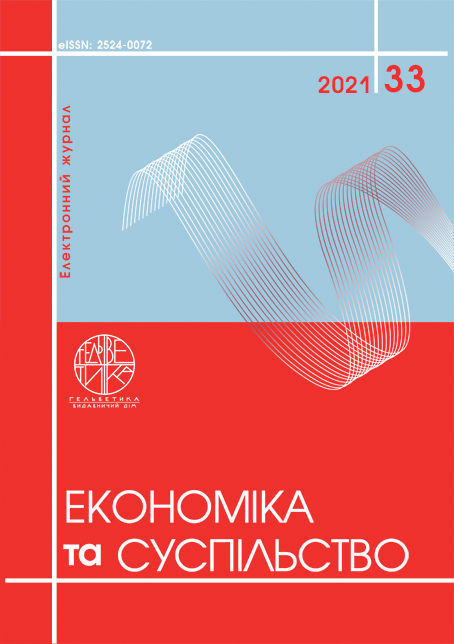ТЕОРЕТИКО-МЕТОДИЧНИЙ АНАЛІЗ КОНЦЕПЦІЇ «СОЦІАЛЬНО-ЕКОЛОГІЧНОЇ СТІЙКОСТІ» ТА МЕХАНІЗМІВ ЇЇ ПІДТРИМКИ ЧЕРЕЗ СПЕЦИФІЧНИЙ КОМПОНЕНТ МІЖСЕКТОРНОГО ПАРТНЕРСТВА
Анотація
Все більш активно розглядається питання того, як бізнес-моделі створюють та вимірюють економічну цінність у соціально-екологічних системах, проте наявні наукові праці не в повному обсязі відповідають на питання, як організації сталих бізнес-моделей, основним і відмінним механізмом яких є міжсекторні партнерства, можуть підтримувати соціально-екологічну сталість. На основі проведеного аналізу сучасної наукової літератури, у статті сформовано теоретичний підхід щодо розширення наявних методик підтримки соціально-екологічної стійкості з точки зору “комплексної адаптивної системи” (КАС). Розроблено структуру, яка визначає ключові стратегічні, інституційні та навчальні елементи партнерства, на які покладаються сталі бізнес-моделі для підтримки соціально-екологічної стійкості. Завдяки проведеному дослідженню даної структури підтверджено важливість оцінки бізнес-ініціатив з точки зору їх впливу на сталість на рівні соціально-екологічних систем, а не лише організацій. В дослідженні проаналізовано, яким чином міжсекторні партнерства забезпечують організаційну підтримку бізнес-моделей для розвитку соціально-екологічної стійкості. Поєднуючи ключові особливості КАС та ключові елементи партнерства, можливим стає розуміння потенціалу та важливості завдання створення міжсекторних партнерств, котрі б підтримували соціо-екологічну стійкість та давали б змогу уникати та/або комплексно вирішувати непередбачувані системні проблеми як на рівні організацій так і поза їх межами в цілому. Ці елементи міжсекторного партнерства потребують розгляду та взаємоузгодження для забезпечення та створення соціальної та екологічної цінності, та подальшого дослідження щодо їх можливого впливу на соціально-екологічну стійкість.
Посилання
Schaltegger, S., Hansen, E. G., & Lüdeke-Freund, F. (2016). Business models for sustainability: Origins, present research, and future avenues. Organization & Environment, 29(3), 264–289.
Whiteman, G., Walker, B., & Perego, P. (2013). Planetary boundaries: Ecological foundations for corporate sustainability. Journal of Management Studies, 50(2), 307–336.
Folke, C. (2006). Resilience: The emergence of a perspective for social–ecological systems analyses. Global Environmental Change, 16(3), 253–267.
Boin, A., Comfort, L. K., & Demchak, C. C. (2010). The rise of resilience. In L. K. Comfort, A. Boin & C. C. Demchak (Eds.), Designing resilience: Preparing for extreme events (pp. 1–12). University of Pittsburgh Press.
Carpenter, S. R., Walker, B. H., Anderies, J. M., & Abel, N. (2001). From metaphor to measurement: Resilience of what to what? Ecosystems, 4, 765–781.
Walker, B., Holling, C. S., Carpenter, S. R., & Kinzig, A. (2004). Resilience, adapt- ability and transformability in social–ecological systems. Ecology and Society, 9(2), Article 5.
Holling, C. S. (1973). Resilience and stability of ecological systems. Annual Review of Ecology and Systematics, 4, 1–23.
Berkes, F., Colding, J., & Folke, C. (2003). Navigating social–ecological systems: Building resilience for complexity and change. Cambridge University Press. 5(1), 16.
Gunderson, L. H., & Holling, C. S. (2002). Panarchy: Understanding transforma- tions in human and natural systems. Island Press. 11(4), 11-12.
Norberg, J., & Cumming, G. S. (2006). Complexity theory for a sustainable future. Columbia University Press. 6(1), 17.
Smit, B., & Wandel, J. (2006). Adaptation, adaptive capacity and vulnerability. Global Environmental Change, 16(3), 282–292.
Kinzig, A. P., Ryan, P., Etienne, M., Elmqvist, T., Allison, H. E., & Walker, B. H. (2006). Resilience and regime shifts: Assessing cascading effects. Ecology and Society, 11(1), Article 20.
Clarke, A., & Crane, A. (2018). Cross-sector partnerships for systemic change: Systematized literature review and agenda for further research. Journal of Business Ethics, 150(2), 303–313.
Olsson, P., Folke, C., & Berkes, F. (2004). Adaptive comanagement for building resil- ience in social–ecological systems. Environmental Management, 34(1), 75–90.
Inigo, E. A., & Albareda, L. (2016). Understanding sustainable innovation as a complex adaptive system: A systemic approach to the firm. Journal of Cleaner Production, 126, 1–20.
Kauffman, S. (1995). At home in the universe: The search for the laws of self- orga- nization and complexity. Oxford University Press, 2(1), 8.
Boisot, M., & Child, J. (1999). Organizations as adaptive systems in complex envi- ronments: The case of China. Organization Science, 10(3), 237–252.
Winn, M. I., & Pogutz, S. (2013). Business, ecosystems, and biodiversity: New hori- zons for management research. Organization & Environment, 26(2), 203–229.
Heuer, M. (2011). Ecosystem cross-sector collaboration: Conceptualizing an adaptive approach to sustainability governance. Business Strategy and the Environment, 20(4), 211–221.
Seitanidi, M. (2008). Adaptive responsibilities: Nonlinear interactions in cross sector social partnerships. Emergence: Complexity & Organization, 10(3), 51–64.
Le Ber, M. J., & Branzei, O. (2010). Towards a critical theory of value creation in cross-sector partnerships. Organization, 17(5), 599–629.
Laasch, O. (2018). Beyond the purely commercial business model: Organizational value logics and the heterogeneity of sustainability business models. Long Range Planning, 51(1), 158–183.
Ashraf, N., Pinkse, J., Ahmadsimab, A., Ul-Haq, S., & Badar, K. (2019). Divide and rule: The effects of diversity and network structure on a firm’s sustainability performance. Long Range Planning, 52(6), Article 101880.
Brown, S. L., & Eisenhardt, K. M. (1997). The art of continuous change: Linking complexity theory and time-paced evolution in relentlessly shifting organiza- tions. Administrative Science Quarterly, 42, 1–34.
Martins, L. L., Rindova, V. P., & Greenbaum, B. E. (2015). Unlocking the hidden value of concepts: A cognitive approach to business model innovation. Strategic Entrepreneurship Journal, 9(1), 99–117.
Dentoni, D., Waddell, S., & Waddock, S. (2017). Pathways of transformation in global food and agricultural systems: Implications from a large-systems change theory perspective. Current Opinion in Environmental Sustainability, 29, 8–13.
Parkhill, K. A., Shirani, F., Butler, C., Henwood, K. L., Groves, C., & Pidgeon, N.F. (2015). “We are a community [but] that takes a certain amount of energy”: Exploring shared visions, social action, and resilience in place-based community- led energy initiatives. Environmental Science & Policy, 53, 60–69.
Schaltegger, S., Hansen, E. G., & Lüdeke-Freund, F. (2016). Business models for sustainability: Origins, present research, and future avenues. Organization & Environment, 29(3), 264–289.
Whiteman, G., Walker, B., & Perego, P. (2013). Planetary boundaries: Ecological foundations for corporate sustainability. Journal of Management Studies, 50(2), 307–336.
Folke, C. (2006). Resilience: The emergence of a perspective for social–ecological systems analyses. Global Environmental Change, 16(3), 253–267.
Boin, A., Comfort, L. K., & Demchak, C. C. (2010). The rise of resilience. In L. K. Comfort, A. Boin & C. C. Demchak (Eds.), Designing resilience: Preparing for extreme events (pp. 1–12). University of Pittsburgh Press.
Carpenter, S. R., Walker, B. H., Anderies, J. M., & Abel, N. (2001). From metaphor to measurement: Resilience of what to what? Ecosystems, 4, 765–781.
Walker, B., Holling, C. S., Carpenter, S. R., & Kinzig, A. (2004). Resilience, adapt- ability and transformability in social–ecological systems. Ecology and Society, 9(2), Article 5.
Holling, C. S. (1973). Resilience and stability of ecological systems. Annual Review of Ecology and Systematics, 4, 1–23.
Berkes, F., Colding, J., & Folke, C. (2003). Navigating social–ecological systems: Building resilience for complexity and change. Cambridge University Press. 5(1), 16.
Gunderson, L. H., & Holling, C. S. (2002). Panarchy: Understanding transforma- tions in human and natural systems. Island Press. 11(4), 11-12.
Norberg, J., & Cumming, G. S. (2006). Complexity theory for a sustainable future. Columbia University Press. 6(1), 17.
Smit, B., & Wandel, J. (2006). Adaptation, adaptive capacity and vulnerability. Global Environmental Change, 16(3), 282–292.
Kinzig, A. P., Ryan, P., Etienne, M., Elmqvist, T., Allison, H. E., & Walker, B. H. (2006). Resilience and regime shifts: Assessing cascading effects. Ecology and Society, 11(1), Article 20.
Clarke, A., & Crane, A. (2018). Cross-sector partnerships for systemic change: Systematized literature review and agenda for further research. Journal of Business Ethics, 150(2), 303–313.
Olsson, P., Folke, C., & Berkes, F. (2004). Adaptive comanagement for building resil- ience in social–ecological systems. Environmental Management, 34(1), 75–90.
Inigo, E. A., & Albareda, L. (2016). Understanding sustainable innovation as a complex adaptive system: A systemic approach to the firm. Journal of Cleaner Production, 126, 1–20.
Kauffman, S. (1995). At home in the universe: The search for the laws of self- orga- nization and complexity. Oxford University Press, 2(1), 8.
Boisot, M., & Child, J. (1999). Organizations as adaptive systems in complex envi- ronments: The case of China. Organization Science, 10(3), 237–252.
Winn, M. I., & Pogutz, S. (2013). Business, ecosystems, and biodiversity: New hori- zons for management research. Organization & Environment, 26(2), 203–229.
Heuer, M. (2011). Ecosystem cross-sector collaboration: Conceptualizing an adaptive approach to sustainability governance. Business Strategy and the Environment, 20(4), 211–221.
Seitanidi, M. (2008). Adaptive responsibilities: Nonlinear interactions in cross sector social partnerships. Emergence: Complexity & Organization, 10(3), 51–64.
Le Ber, M. J., & Branzei, O. (2010). Towards a critical theory of value creation in cross-sector partnerships. Organization, 17(5), 599–629.
Laasch, O. (2018). Beyond the purely commercial business model: Organizational value logics and the heterogeneity of sustainability business models. Long Range Planning, 51(1), 158–183.
Ashraf, N., Pinkse, J., Ahmadsimab, A., Ul-Haq, S., & Badar, K. (2019). Divide and rule: The effects of diversity and network structure on a firm’s sustainability performance. Long Range Planning, 52(6), Article 101880.
Brown, S. L., & Eisenhardt, K. M. (1997). The art of continuous change: Linking complexity theory and time-paced evolution in relentlessly shifting organiza- tions. Administrative Science Quarterly, 42, 1–34.
Martins, L. L., Rindova, V. P., & Greenbaum, B. E. (2015). Unlocking the hidden value of concepts: A cognitive approach to business model innovation. Strategic Entrepreneurship Journal, 9(1), 99–117.
Dentoni, D., Waddell, S., & Waddock, S. (2017). Pathways of transformation in global food and agricultural systems: Implications from a large-systems change theory perspective. Current Opinion in Environmental Sustainability, 29, 8–13.
Parkhill, K. A., Shirani, F., Butler, C., Henwood, K. L., Groves, C., & Pidgeon, N.F. (2015). “We are a community [but] that takes a certain amount of energy”: Exploring shared visions, social action, and resilience in place-based community- led energy initiatives. Environmental Science & Policy, 53, 60–69.


